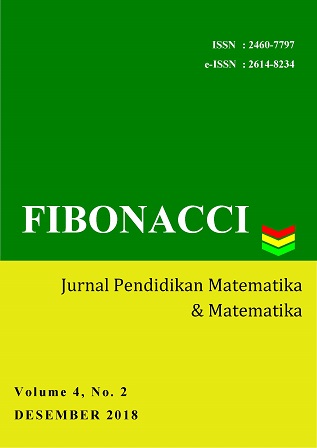PENGARUH MODEL KOOPERATIF TIPE THINK-PAIR-SHARE (TPS) TERHADAP KEMAMPUAN PENYELESAIAN MASALAH DAN DISPOSISI MATEMATIS DITINJAU DARI KEMAMPUAN AWAL SISWA SMP SWASTA ISLAM DI TANGSEL
Main Article Content
Abstract
Article Details
Authors who publish with this journal agree to the following terms:
- Authors retain copyright and grant the journal right of first publication with the work simultaneously licensed under a Creative Commons Attribution License that allows others to share the work with an acknowledgement of the work's authorship and initial publication in this journal.
- Authors are able to enter into separate, additional contractual arrangements for the non-exclusive distribution of the journal's published version of the work (e.g., post it to an institutional repository or publish it in a book), with an acknowledgement of its initial publication in this journal.
- Authors are permitted and encouraged to post their work online (e.g., in institutional repositories or on their website) prior to and during the submission process, as it can lead to productive exchanges, as well as earlier and greater citation of published work (See The Effect of Open Access).
References
Arends, Richard I. 2007. Learning To Teach. New York: Mc Graw Hill Companies.
Chianson, Mimi Martha, O’kwu, Ijenkeli Emmanuel, Kurumeh, Mary
Seraphina. 2015. “Effect Of Think-Pair-Share Strategy On Secondary School Mathematics Students’ Achievement And Academic Self-Esteem In Fractions.” Issue 2 Feb-Mar AIJCSR. Vol. 2, pp:141-147.
Cooke, Audrey. 2015. “Considering Pre-service Teacher Disposition towards Mathematics.” Mathematics Education Research Group of Australasia, Inc. Vol. 17 (1), pp:1-11.
Hamdayana, Jumanta. 2014. Model dan Metode Pembelajaran Kreatif dan Berkarakter. Bogor: Ghalia Indonesia.
Jonassen, D.H. & Grabowski, B.L. 1993. Handbook of individual differences, learning, and instruction. Part VII, Prior knowledge. Hillsdale: Lawrence Erlbaum Associates.
Kadir. 2010. Statistika Untuk Penelitian Ilmu-ilmu Sosial. Jakarta: Rosetama Sampurna.
Kilpatrick, J., Swafford, J., & Findell, B. 2001. Adding It Up: Helping Children Learn Mathematics. Washington, DC: National Academy Press.
Kurniasih, Imas dan Sani, Berlin. 2015. Ragam Pengembangan Model Pembelajaran Untuk Peningkatan Profesionalitas Guru. Yogyakarta: Kata Pena.
Memnum, Dilek Sezgin,. Hart, Lynn C., & Akkaya Recai. 2012 “A Research on the Mathematical Problem Solving Beliefs of Mathematics, Science and Elementary Pre-Service Teachers in Turkey in Terms of Different Variables.” International Journal of Humanities and Social Science. Vol 2 (24), pp:172-184.
NCTM. 1989. Curriculum and Evaluation Standars for School Mathematics. Reston, VA: NCTM.
Peraturan Menteri Pendidikan Nasional Nomor 22 Tahun 2006 Tentang Standar Isi Untuk Satuan Pendidikan Dasar dan Menengah. Jakarta: Permendiknas.
PISA. 2012. PISA 2012 Result in Focus, What 15-Year-Olds Know and What They Can do With What They Know. Paris: The Organitation for Economic Co-operation and Development Publications.
Polya, G. 2004. How to Solve It. Princeton: Princeton University Press.
Reigeluth, C. M. 1999. Instructional Design Theories and Models. London: Lawrence Erlbaum.
Sujarweni, V Wiratna. 2014. SPSS Untuk Penelitian. Yogyakarta: Pustaka Baru Press.
Sumarmo, Utari. 2012. Bahan Belajar Matakuliah Proses Berpikir Matematika. Bandung: Program S2 Pendidikan Matematika STKIP Siliwangi.
_____________. 2012. Pendidikan Karakter Dan Pengembangan Kemampuan Berpikir Dan Disposisi Matematik Serta Pembelajarannya. Bandung: Jurusan Pendidikan Matematika Fakultas Pendidikan MIPA UPI.
TIMSS. 2011. TIMSS 2011 International Result In Mathematics. Boston: TIMSS & PIRLS International Study Center, 5-48.
Tint, San San & Ei Ei Nyunt. 2015. “Collaborative Learning With Think-Pair-Share Technique.” Computer Applications: An International Journal (CAIJ). Vol 2 (1), pp: 1-11.
Turmudi. 2008. Landasan Filsafat dan Teori Pembelajaran Matematika (Berparadigma Eksploratif dan Investigatif). Jakarta: PT Leuser Cita Pustaka.
White, Dorothy Y. Eileen C. Murray Victor Brunaud-Vega. 2012. “Discovering Multicultural Mathematics Dispositions.” Journal of Urban Mathematics Education. Vol. 5 (1), pp: 31–43.

